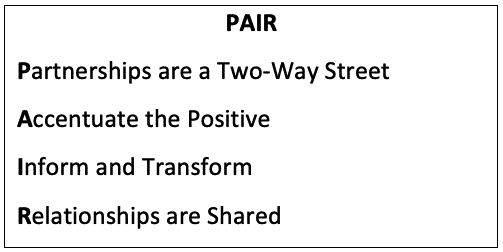Table of Contents
Partnering with the parents and families of your students provides advantages to you, your students, and to their families for student success. Families will have a better idea of what’s happening in school, which also allows them to help support their son or daughter at home. Students benefit when they receive encouragement at home. And teachers benefit when learning is reinforced and supported by parents and families. Let’s discuss how to PAIR with parents and families to improve student learning. Please note that I’ll be using the word parents but consider it all
PAIR with Parents

Partnerships are a Two-Way Street
A true partnership is more than communication from school to home. Although it’s our responsibility to take the initiative to form partnerships, everyone has a role. I’ve found that most parents are willing to help, but they need specific ways to help.
Kendra Alston, a former teacher in Charlotte-Mecklenburg Schools in North Carolina, used interactive homework. “For example, I’ll take a picture of something my students did in school. Then, I write ‘ask me what I learned today’ at the top of the page. The parents have to write what their son or daughter said. This lets me know if the students even remember what happened. I’m also always about getting feedback on my own performance and when the parent writes a reflection on what their child is learning, it gives you insight on how well you taught.”
It’s also helpful to provide parents a list of ways they can help at home. This should include clear guidelines of what constitutes appropriate help (doing their science project for them isn’t) and any other simple tips, such as setting a time for homework. Many elementary schools send home a monthly calendar to post on the refrigerator. Each day has a simple activity families can do together.
Accentuate the Positive
I called every parent during the first month of school to introduce myself and tell them something positive about their son or daughter. I thought of parent relationships like a bank; I needed to make a deposit before I made a withdrawal. I didn’t want my first phone call to be the one about a poor grade or a discipline problem. One time it took 17 calls to reach a parent before I was finally successful. It took about five minutes to convince her I wasn’t calling because Marcus was in trouble. She finally said she had never received a call from a teacher telling her something positive about her son. She thanked me and immediately offered her help anytime I needed it. Five weeks later when Marcus was in trouble in class, she supported me 100%. Focusing on the positive has benefits for you, your students, and their parents.
There are a variety of social media tools you can use to communicate with parents and to share positive news. As a caution, be sure you are protecting the privacy of your classroom and your students. For example, on Pinterest, don’t name your boards with your location or your full name. Also, there are private blogs that require invitations or membership, so you can control who sees the information.
Inform and Transform
When I talk to parents, many of them feel as though there is a hidden code in schools; a code they don’t understand. Margo and her son moved to a new area when Jared started middle school. She missed the first parent-teacher meeting because she was working. She called the school and left several messages asking to meet with his teachers, but didn’t receive a return call. Margo was frustrated when she told me her story. Another teacher at the school was in one of my classes, so I talked with her. I discovered that the school had a policy that all appointments with teachers were scheduled with the attendance secretary, so the entire teaching team could meet with parents without scheduling conflicts. My graduate student said the principal always explained the policy at the first meeting. So of course, Margo didn’t know because she wasn’t at the meeting, and she thought the teachers were just ignoring her. One phone call later, she connected with the teachers, and she and Jared finished the year successfully. You can communicate with parents via newsletters (email or paper), social media, parent-teacher meetings, brochures, or webpages.
Relationships are Shared
Many partnerships are destroyed before they start, because the teacher believes it is someone else’s responsibility to prompt a connection. This was exactly the attitude of my former colleague. If you believe it’s the parents’ responsibility to communicate and/or follow-up with you, that attitude comes through when you talk with them. Communicating with parents is not an extra job; it is part of your job. There is no way you can truly help your students be successful without the support of their parents. And it’s up to you to take the first step. Suzanne Okey, a former teacher of students with special needs, points out that sometimes PTA meetings and phone calls are not enough.
In terms of families, I’m big on home visits. I feel like it’s always fair to get off your turf and go into the environment where they are most comfortable. It says this is a two way street; I’m not expecting you to make all the accommodations; I’ll meet you where you are. If teachers truly want to form partnerships, they cannot expect it all to be “come to me”; you have to be willing to go to them. Sometimes I sent a letter. It is important to give them options, such as meeting them in neutral places (the public library or McDonald’s) in order to preserve their privacy and dignity. Not everyone has transportation or telephones, and they don’t want to advertise that to world.
It’s our responsibility to connect with parents; and the benefits outweigh any costs in terms of time.
A Final Note
Relationships with parents and families can be challenging, but they are a critical aspect to a student’s learning. There are specific strategies that will help you connect and build relationships.
- Harvard Business Review – How Working Parents Can Prepare for Coronavirus Closures
- The Atlantic – How College Changes the Parent-Child Relationship
- edCircuit – 4 Ways to Implement Change: The BASE Model



